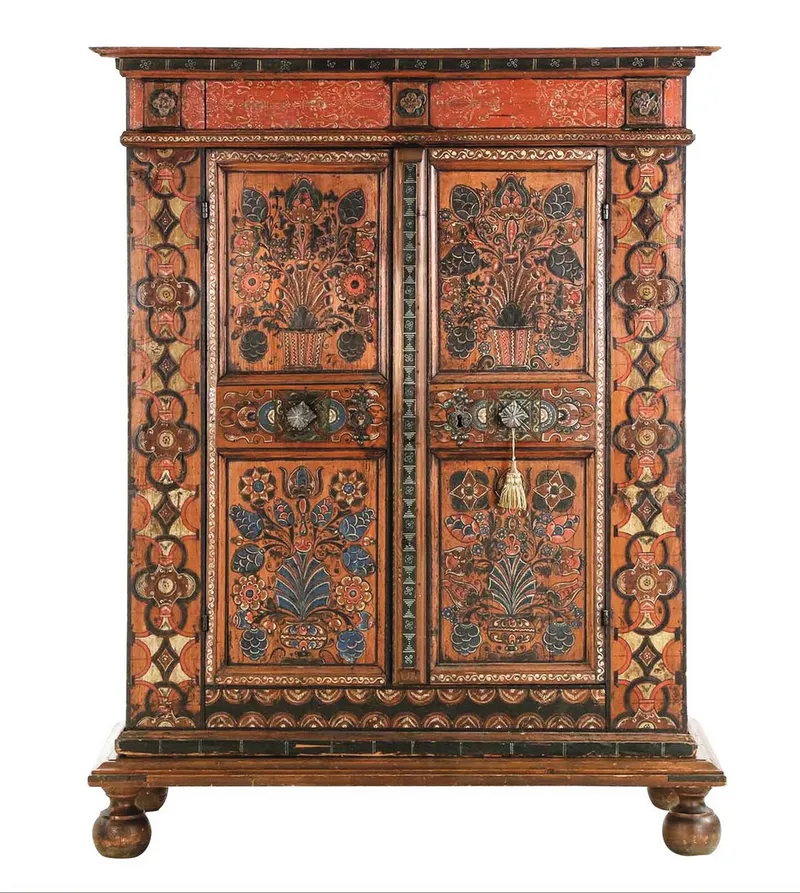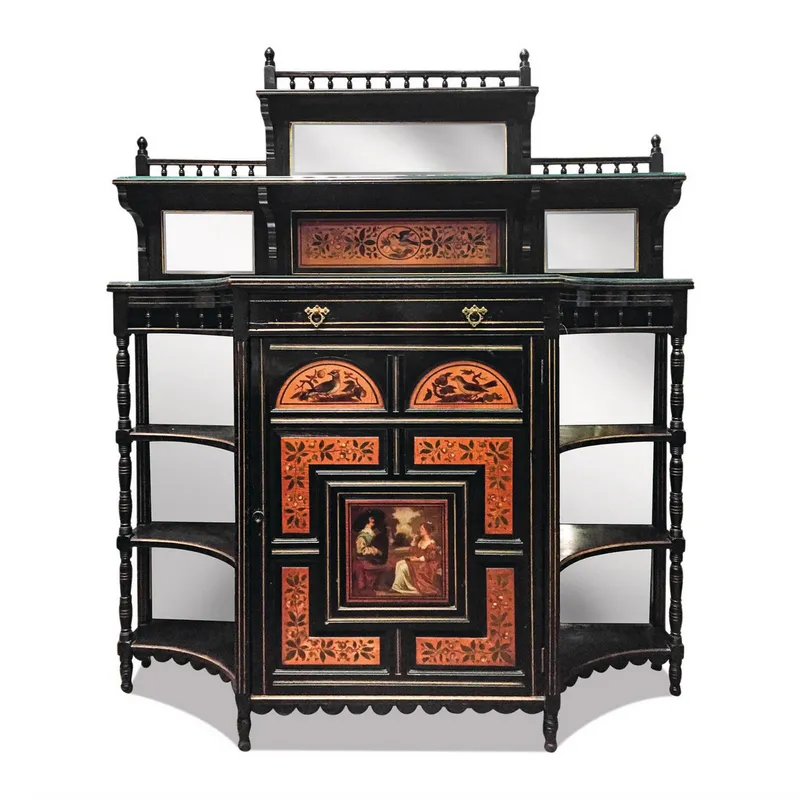Trends in interior design have always affected the antiques market: the whims of leading decorators influencing what is in and what is out. Think of the country house-loving 1980s, when British homes gleamed with Georgian furniture – mahogany bureaux, breakfront cabinets – set against a backdrop of chintzes and frilly-knicker blinds. By the Noughties it was the turn of mid-century modern: lean, spiky-legged pieces echoing the minimalist look of interiors.

So what will we be buying in 2024? Anyone who has visited last year’s key antiques events, such as LAPADA or The Decorative Antiques and Textiles Fair in Battersea, will know that this decade looks poised to be very different. Instead of one distinct look, a cocktail of design influences is fuelling a refreshingly diverse antiques scene, from a resurgence in craft to the use of textiles as art.
As the antiques dealer and interior designer Max Rollitt puts it: ‘In our grandparents’ day there was a rather formulaic and formal approach to antiques. They were a status symbol and their use complied with a perception of the correct way of living. We’ve let this go and can look at antiques with a different eye – more of an artist’s eye. Vanessa Bell and Duncan Grant exemplified this style at their Charleston farmhouse.’
At Foster & Gane, known for its design-led pieces, Val Foster notes the use of craft in interiors percolating down to the antiques market, shaping collecting choices. This is reflected in a renewed appreciation for Arts and Crafts furniture and the movement’s reaction against mass production. ‘It was based on careful, honest hand making, with respect for the materials used,’ Val explains.

That ethos, of course, feels very current. ‘There’s now such emphasis on sustainability and harmony with nature, using simple skills to make something beautiful and enduring, which won’t be chucked out in the short term,’ she adds.
At Fisher London, a twinkling antiques emporium on London’s sombre Gray’s Inn Road, frequented by designers such as Jonathan Anderson, owner Hilary Fisher keeps a weather eye on design trends. She notes that Japanese Imari plates have become popular with decorators, who use them to adorn clients’ walls in dancing displays of lustrous oranges and deep blues. Georgian glass – particularly wine glasses and decanters – with its perfectly imperfect allure, is also in demand.

‘We’ve had commissions for large runs of 18th-century glass: one from an established English dealer and designer who’s just opened a new showroom in New York, another from a young decorator working on a large stately home in York. Antique glass is having a moment,’ says Hilary.
This includes early 20th-century American glass by Tiffany, or its less expensive equivalent, Steuben, says specialist Mike Moir. ‘Brexit has made it so much harder to buy in Europe, that buying from American salerooms, where they’re familiar with the paperwork, feels relatively easy. And because it’s over 100 years old, taxes are lower. But apart from that, it’s just fabulous glass,’ he says.
Tiffany’s organic ‘Lava’ or ‘Paperweight’ vases in rare colours such as reds, yellows or blues are worth looking out for. So too more modestly priced Steuben pieces (produced from 1905) which are ‘like Tiffany, but funkier’, according to Mike.
Hilary Fisher also points to the enduring influence of the late dealer-decorator Robert Kime, whose collection sold for astral sums at Dreweatts last autumn. Like others of his ilk – Geoffrey Bennison and Christopher Gibbs – the scholarly Kime, says Hilary, was ‘all about creating a comfortable, layered room with points of interest without sticking to a prescribed template.’

Kime’s distinctive use of antique textiles – tactile weaves dashed across sofas or displayed on walls – has driven sales of fabrics like ikats or suzanis from Uzbekistan in recent years. Interior designer Kate Guinness, known for her colour-steeped, comfortable interiors, is a particular fan of West African Kente cloth – woven for ceremonial dress – which she displays as artworks at home and for clients.
Specialist dealer Ian Shaw, who has spent time exploring the regional variations of Kente, says that pre 20th-century weaves in muted, autumnal hues are particularly sought after. ‘We hang them from rails using clips. Each is a one off. And you never tire of them; the dexterity of the weave, the intricate motifs – hands, chairs, animals. There’s always something to look at,’ he says, adding: ‘you can make a big statement with one piece and nothing else at all.’

Octavia Dickinson is another designer using antiques with a light touch. She is currently drawn to pieces from the Aesthetic Movement which, as expert Martin Levy, of H. Blairman & Sons, explains, grew out of the Gothic Revival. ‘It had its heyday in the 1870s when it was driven by an elite group of designers and artists like Godwin or Whistler,’ he says.
The Japanese-influenced style, epitomised by ebonised wood with gilded details, continues Martin, ‘trickled down to manufacturers. Pieces by Lamb or Robert Gillow were highly attractive and appealing to live with.’ Octavia agrees, singling out a ‘playful’ ribbed-leg walnut table in her online shop as epitomising the movement’s ‘art for art’s sake’ ethos. ‘The romantic design associated with the British movement is joyful,’ she says.

In kitchens, the move from glossy cabinetry to a more unfitted look has put the spotlight on functional antiques, such as armoires, sideboards and refectory tables, all of them made more desirable if they bear the patina of time. Octavia also notes an increase in requests for dressers. ‘The design is so clever and practical, with display shelves at the top, hooks for hanging mugs and jugs, and a worktop below,’ she says.
Another designer, Kate Cox of HÁM Interiors, a family-run practice known for its expressive schemes, uses an antique, tiled dairy table as a chopping and entertaining surface in her Bristol kitchen. Antiques, she says, ‘bring the slight sense of disorder that I find pleasing’.
The general move towards a quieter aesthetic has put decorative lighting in the spotlight. While these elaborate designs might have looked fussy in a maximalist scheme, in more subdued settings, glowing antique sconces or lamps can really draw the eye, like a beguiling pendant on a black dress. Leading designer Rose Uniacke favours setting pieces from the Viennese Secessionist movement against her hallmark airy backdrops.

And at Foster & Gane, a sinuous pendant by René Lalique sold as soon as their stand at The Decorative Fair opened in October. ‘We’ve noticed a change, from clients using our lights in period homes to more modern settings,’ observes Martin Ashby of early 20th-century specialist Ashby Interiors.
He singles out pieces by WAS Benson. An architect turned designer, Benson capitalised on the introduction of electricity in the early 1900s to design experimental lighting; Arts and Crafts pieces (often with the firm’s stamp) becoming increasingly avant-garde – brass forms fashioned into lily pads embraced by floral decoration. Artworks in their own right, they should, says Martin, ‘never go out of fashion’.